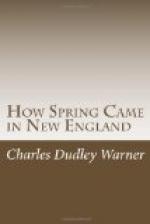And yet Paris is the universe. Strange anomaly! The greater must include the less; but how if the less leaks out? This sometimes happens.
And yet there are phenomena in that country worth observing. One of them is the conduct of Nature from the 1st of March to the 1st of June, or, as some say, from the vernal equinox to the summer solstice. As Tourmalain remarked, “You’d better observe the unpleasant than to be blind.” This was in 802. Tourmalain is dead; so is Gross Alain; so is little Pee-Wee: we shall all be dead before things get any better.
That is the law. Without revolution there is nothing. What is revolution? It is turning society over, and putting the best underground for a fertilizer. Thus only will things grow. What has this to do with New England? In the language of that flash of social lightning, Beranger, “May the Devil fly away with me if I can see!”
Let us speak of the period in the year in New England when winter appears to hesitate. Except in the calendar, the action is ironical; but it is still deceptive. The sun mounts high: it is above the horizon twelve hours at a time. The snow gradually sneaks away in liquid repentance. One morning it is gone, except in shaded spots and close by the fences. From about the trunks of the trees it has long departed: the tree is a living thing, and its growth repels it. The fence is dead, driven into the earth in a rigid line by man: the fence, in short, is dogma: icy prejudice lingers near it. The snow has disappeared; but the landscape is a ghastly sight, —bleached, dead. The trees are stakes; the grass is of no color; and the bare soil is not brown with a healthful brown; life has gone out of it. Take up a piece of turf: it is a clod, without warmth, inanimate. Pull it in pieces: there is no hope in it: it is a part of the past; it is the refuse of last year. This is the condition to which winter has reduced the landscape. When the snow, which was a pall, is removed, you see how ghastly it is. The face of the country is sodden. It needs now only the south wind to sweep over it, full of the damp breath of death; and that begins to blow. No prospect would be more dreary.
And yet the south wind fills credulous man with joy. He opens the window. He goes out, and catches cold. He is stirred by the mysterious coming of something. If there is sign of change nowhere else, we detect it in the newspaper. In sheltered corners of that truculent instrument for the diffusion of the prejudices of the few among the many begin to grow the violets of tender sentiment, the early greens of yearning. The poet feels the sap of the new year before the marsh-willow. He blossoms in advance of the catkins. Man is greater than Nature. The poet is greater than man: he is nature on two legs,—ambulatory.
At first there is no appearance of conflict. The winter garrison seems to have withdrawn. The invading hosts of the South are entering without opposition. The hard ground softens; the sun lies warm upon the southern bank, and water oozes from its base. If you examine the buds of the lilac and the flowering shrubs, you cannot say that they are swelling; but the varnish with which they were coated in the fall to keep out the frost seems to be cracking. If the sugar-maple is hacked, it will bleed,—the pure white blood of Nature.




